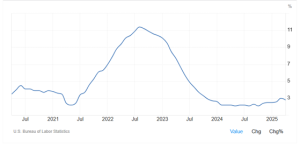This morning, the U.S. Bureau of Labor Statistics released new data on inflation confirming what many of us have felt at the register: grocery prices are rising again. In particular, the data show the Consumer Price Index for food rose .3% in May of 2025, bringing annual food inflation up to 2.9% compared to May of 2024.
Food prices played an outsized role in the last election. To quote the President, “I won on groceries. Very simple word, groceries. When you buy apples, when you buy bacon, when you buy eggs, they would double and triple the price over a short period of time, and I won an election based on that. We’re going to bring those prices way down.”
But Trump and the Republicans in Congress have not brought prices “way down.” To the contrary, tariffs and other new federal policies appear to be driving up food prices and resurrecting the inflationary headwinds that originated with the COVID pandemic and its associated production shortages. Those headwinds had begun to subside in the final months of the Biden Administration, as shown in the graph below.
U.S. FOOD PRICE INFLATION
Why is the price of food (other than eggs) rising now? The most obvious culprit is tariffs. Paid by companies importing foreign goods, tariffs act as a sales tax. These taxes push up the price of imported foods like seafood and coffee. They also increase the price of domestically produced goods that contain imported components, like beer and soup sold in cans made from imported steel and aluminum, now subject to 50% tariffs.
To be sure, tariffs account for only a fraction of food prices, and economists disagree on the extent to which other factors like the war in Ukraine or federal deficit spending have added to the inflationary pressures set off by the pandemic. Notably the “Big Beautiful Bill Act” passed by the House last month would add $3.0 trillion to the deficit over the next 10 years, according to the Congressional Budget Office, and most economists agree higher debt adds to inflationary pressures. But the impact of any single policy on food inflation is tough to pin down.
Even so, there is good reason to expect food prices to continue to rise. Why? As we have written before, food inflation festers in countries with less freedom. And in less than five months of Trump 2.0, the hallmarks of authoritarian government are everywhere: a politicized federal law enforcement apparatus, an aggrandized executive coopting a compliant Congress, rampant disinformation, efforts to cow independent media and academia, disregard for due process, and a zeal to foment violence in places like Los Angeles.
As the ruling party’s political opponents struggle to respond, a vacuum of democratic accountability has given way to a feeding frenzy of fraud and grift, with the President’s cryptocurrency ventures exemplifying the bottomless potential for depravity. Corruption provides the most coherent explanation for Trump 2.0’s chaotic tariff regime, with its ample opportunities for kickbacks and insider trading. Corruption likewise explains the conspicuous absence in the Administration’s trade agenda of policy reforms that might benefit the nation’s workers, farmers, rural communities, environment, or consumers.
Where does this leave consumers fed up with high food prices? Fortunately, a few policymakers continue to work to protect consumers. For example, one lesson learned from the pandemic is that many food companies, when pressured to raise prices, prefer to deceive consumers with “shrinkflation” rather than risk losing out to competitors. Rep. Lou Correa introduced a bill that would address some of the worst of these abuses. Congressional democrats have also sought to definitively revoke the President’s legally suspect authority for jacking up tariffs under the International Emergency Economic Powers Act.
These bills have little hope of success in the current Congress. But that does not mean constituents should not demand answers from representatives that refuse to act in their interest. At the same time, proponents of democratic government in the United States should reckon with the underlying rot that led so many Americans to vote for candidates they view as “disruptors” to the status quo. Outrageously, as the Trump family’s shenanigans generate billions of dollars a month in illicit wealth, sixteen Senate democrats voted last month to advance a bill that would legitimize the Trumps’ crypto grift and move us closer to a dystopia in which Trump’s World Liberty Financial “stable coin” replaces the dollar as the medium for government payments like Social Security.
Why would Democrats support such a bill? Maybe because the crypto industry accounted for nearly half of all corporate money in the 2024 election, pouring money into ads about pretty much anything but crypto. Indeed, the country’s campaign finance system seems bound to become only more unsustainable in the wake of the Supreme Court’s Citizens United ruling. Rising food prices may soon force a change.


